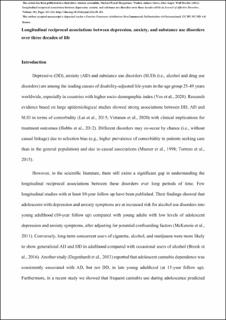Please use this identifier to cite or link to this item:
https://doi.org/10.21256/zhaw-24233Full metadata record
| DC Field | Value | Language |
|---|---|---|
| dc.contributor.author | Amendola, Simone | - |
| dc.contributor.author | Hengartner, Michael Pascal | - |
| dc.contributor.author | Ajdacic-Gross, Vladeta | - |
| dc.contributor.author | Angst, Jules | - |
| dc.contributor.author | Rössler, Wulf | - |
| dc.date.accessioned | 2022-02-15T08:12:08Z | - |
| dc.date.available | 2022-02-15T08:12:08Z | - |
| dc.date.issued | 2022-01-29 | - |
| dc.identifier.issn | 0165-0327 | de_CH |
| dc.identifier.issn | 1573-2517 | de_CH |
| dc.identifier.uri | https://digitalcollection.zhaw.ch/handle/11475/24233 | - |
| dc.description.abstract | Background and objective: Studies exploring longitudinal reciprocal associations between depressive, anxiety, and substance use disorders (DD, AD and SUD, respectively) over long periods of time are mainly lacking. Therefore, the aim of the present study is to test longitudinal associations (i.e. temporal dynamics) between DD, AD and SUD from young adulthood to middle adulthood. Methods: A stratified community sample of 591 participants from the canton of Zurich, Switzerland, was inter-viewed with the Structured Psychopathological Interview and Rating of the Social Consequences of Psychological Disturbances for Epidemiology over seven interview waves from ages 20/21 to 49/50. Diagnostic and Statistical Manual of Mental Disorders criteria were used to evaluate the presence of DD, AD and SUD. We fitted an auto-regressive cross-lagged path analysis within a Bayesian structural equation model to test longitudinal associations. Results: Regarding autoregressive effects, AD (except during young adulthood) and SUD predicted themselves over the entire time period, while DD recurrently predicted itself not consistently over time. Regarding cross-lagged effects, DD predicted SUD at different time points, and vice versa. DD predicted subsequent AD in adulthood, whereas the reverse did not happen. Female gender was associated with DD and AD at all ages while male gender was associated with SUD only in young adulthood. Conclusions: Reciprocal longitudinal associations were found between DD and SUD and DD usually preceded AD. Our results further confirm an increased risk of DD and AD in women and a higher risk of SUD in young men. Early treatment and broad psychosocial interventions should be provided in order to prevent chronicity and further maladjustment as well as interrupting the cycle of mutual reinforcement between DD and SUD. | de_CH |
| dc.language.iso | en | de_CH |
| dc.publisher | Elsevier | de_CH |
| dc.relation.ispartof | Journal of Affective Disorders | de_CH |
| dc.rights | https://creativecommons.org/licenses/by-nc-nd/4.0/ | de_CH |
| dc.subject | Community sample | de_CH |
| dc.subject | Comorbidity | de_CH |
| dc.subject | Course | de_CH |
| dc.subject | Epidemiology | de_CH |
| dc.subject | Prospective | de_CH |
| dc.subject | Psychiatric disorder | de_CH |
| dc.subject.ddc | 616.8: Neurologie und Krankheiten des Nervensystems | de_CH |
| dc.title | Longitudinal reciprocal associations between depression, anxiety, and substance use disorders over three decades of life | de_CH |
| dc.type | Beitrag in wissenschaftlicher Zeitschrift | de_CH |
| dcterms.type | Text | de_CH |
| zhaw.departement | Angewandte Psychologie | de_CH |
| zhaw.organisationalunit | Psychologisches Institut (PI) | de_CH |
| dc.identifier.doi | 10.1016/j.jad.2022.01.101 | de_CH |
| dc.identifier.doi | 10.21256/zhaw-24233 | - |
| dc.identifier.pmid | 35093414 | de_CH |
| zhaw.funding.eu | No | de_CH |
| zhaw.originated.zhaw | Yes | de_CH |
| zhaw.pages.end | 323 | de_CH |
| zhaw.pages.start | 315 | de_CH |
| zhaw.publication.status | acceptedVersion | de_CH |
| zhaw.volume | 302 | de_CH |
| zhaw.embargo.end | 2023-01-30 | de_CH |
| zhaw.publication.review | Peer review (Publikation) | de_CH |
| zhaw.webfeed | Klinische Psychologie | de_CH |
| zhaw.author.additional | No | de_CH |
| zhaw.display.portrait | Yes | de_CH |
| Appears in collections: | Publikationen Angewandte Psychologie | |
Files in This Item:
| File | Description | Size | Format | |
|---|---|---|---|---|
| 2022_Amendola-etal_Longitudinal-reciprocal-associations_JAD.pdf | 394.44 kB | Adobe PDF |  View/Open |
Show simple item record
Amendola, S., Hengartner, M. P., Ajdacic-Gross, V., Angst, J., & Rössler, W. (2022). Longitudinal reciprocal associations between depression, anxiety, and substance use disorders over three decades of life. Journal of Affective Disorders, 302, 315–323. https://doi.org/10.1016/j.jad.2022.01.101
Amendola, S. et al. (2022) ‘Longitudinal reciprocal associations between depression, anxiety, and substance use disorders over three decades of life’, Journal of Affective Disorders, 302, pp. 315–323. Available at: https://doi.org/10.1016/j.jad.2022.01.101.
S. Amendola, M. P. Hengartner, V. Ajdacic-Gross, J. Angst, and W. Rössler, “Longitudinal reciprocal associations between depression, anxiety, and substance use disorders over three decades of life,” Journal of Affective Disorders, vol. 302, pp. 315–323, Jan. 2022, doi: 10.1016/j.jad.2022.01.101.
AMENDOLA, Simone, Michael Pascal HENGARTNER, Vladeta AJDACIC-GROSS, Jules ANGST und Wulf RÖSSLER, 2022. Longitudinal reciprocal associations between depression, anxiety, and substance use disorders over three decades of life. Journal of Affective Disorders. 29 Januar 2022. Bd. 302, S. 315–323. DOI 10.1016/j.jad.2022.01.101
Amendola, Simone, Michael Pascal Hengartner, Vladeta Ajdacic-Gross, Jules Angst, and Wulf Rössler. 2022. “Longitudinal Reciprocal Associations between Depression, Anxiety, and Substance Use Disorders over Three Decades of Life.” Journal of Affective Disorders 302 (January): 315–23. https://doi.org/10.1016/j.jad.2022.01.101.
Amendola, Simone, et al. “Longitudinal Reciprocal Associations between Depression, Anxiety, and Substance Use Disorders over Three Decades of Life.” Journal of Affective Disorders, vol. 302, Jan. 2022, pp. 315–23, https://doi.org/10.1016/j.jad.2022.01.101.
Items in DSpace are protected by copyright, with all rights reserved, unless otherwise indicated.